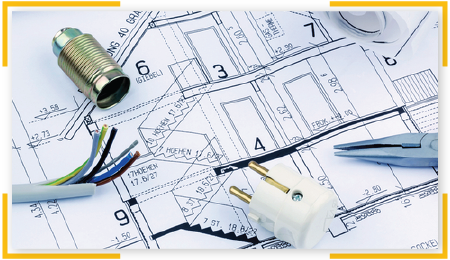
Electrical Engineering Services
How It Works?

Step 1
Send us the architectural floor plans.

Step 2
Our experts will analyze the documents uploaded by you to design electrical plans

Step 3
We send you an optimized electrical plans within 2 weeks per floor.
Get In Touch
Need help or additional information?
Give us a call on
(786) 788-0295
Maximum of 2000 Sq.Ft. per floor
Get in touch - 212-575-5300
Electrical Design Services
- Get your design done in 2 weeks per floor
- Electrical code compliance and quick design approval.
- Avoid wasting money on oversized electrical systems.
- Save electricity with an energy efficient design.
- Reliable and code-compliant electrical protections.
Electrical Engineering Services
Design as per codes
Get an electrical design that meets the NFPA 70 National Electrical Code and local building codes.
Reduce Cost
Reduce the cost of your electrical installation by avoiding oversized components and equipment.
Save Electricity Bills
Save on electricity bills with energy efficiency measures and renewable generation systems.
Cost Effective Electrical Engineering Services

Electrical installations have a very important role in buildings, since they provide an energy source for many appliances and building systems. In modern society, electric current is the fastest and most efficient method to deliver energy. However, the power of electricity also makes it dangerous when not used property, and electrical systems must be safe and reliable.
Buildings use plenty of equipment and devices that run with electricity. There are many types of electrical installations, but they must all meet two common requirements:
- Being able to deliver enough power for all the electrical devices connected, while keeping a stable voltage.
- Operating safely without exposing occupants to electric shock, and without creating fire hazards.
The NFPA 70 National Electrical Code (NEC) is one of the most widely used references for electrical design, not only in the USA but also internationally. The NEC was developed by the National Fire Protection Association, and the first edition was published more than a century ago in 1897. The code is reviewed and updated every three years to keep up with the latest technologies, and the most recent edition was published in 2020. Cities, states and even entire countries have created their local electrical codes based on the NEC.
Delivering enough power and operating safely are basic requirements for all electrical installations. However, electrical engineers also recommend the use of energy efficiency measures. While these measures may increase the initial cost of your electrical systems, every dollar invested is recovered several times during the service life of your building. If the local power grid is dependent on fossil fuels, energy efficiency will also reduce the carbon emissions produced by your building.
Generating electricity on site is now viable, and solar panels in particular can adapt to buildings of all sizes and occupancies. However, a safe and reliable electrical installation is important even when clean energy sources are used. Also, energy efficiency maximizes the value of every kilowatt-hour produced.
Sizing Your Electrical Installations Correctly
Many calculations involved in electrical design have the purpose of finding the optimal size of equipment and components:
- When an installation is undersized, wiring and other components can overheat, causing an early failure and possibly electrical faults. Undersized wiring also causes voltage drop issues, which damage some devices.
- On the other hand, an oversized electrical installation is more expensive than necessary. Unless you plan to add more electrical loads to the system in the future, there is no point in oversizing.
If you are willing to invest more in an electrical installation, energy efficiency measures and renewable generation systems are much better ways to use your budget. Oversizing is not recommended, unless you plan to connect more electrical load in the future.
Sizing an electrical installation is a design process that involves many steps. First of all, electrical engineers must know all the electrical loads that will be connected to the installation. These include lighting fixtures, home appliances, office appliances, air handlers, air conditioning units, pumps and IT equipment.
Electrical loads are then grouped by categories, and similar devices share electrical circuits. For example, installing individual wiring for every lighting fixture is too expensive, and for this reason fixtures are arranged in lighting circuits. If a circuit contains 20 lamps that consume 200 watts each, it must be capable of carrying 4000 watts (4 kilowatts) safely and reliably.
The total current carried by an electrical circuit determines the conductor size. In turn, the wiring diameters of a circuit determine the conduit or raceway where it will be installed. During the electrical design process, engineers calculate wiring and conduit sizes for all the expected loads in a building. These circuits that power electrical appliances and equipment are called branch circuits.
Individual branch circuits are connected to distribution boards, where each of them is protected by a circuit breaker. In turn, distribution boards are powered by larger feeder circuits, which connect to the main electrical service equipment.
Our electrical engineers use Building Information Modeling (BIM) and advanced design software to optimize the layout of all building systems, including electrical installations. By reducing the total length of wire and conduit used in your building, we can reduce the total cost of your electrical systems.
Importance of Having Adequate Electrical Protections

Electrical protections have a very important function in buildings: when an electrical fault occurs, they disconnect the affected circuits immediately. If an electrical circuit is left connected with an active fault, the consequences can include major component damage, fire, or electric shock.
Most electrical protection devices use thermal or magnetic mechanisms to disconnect faults, and many protection devices use both types.
- Thermal protections use the heat released by the high electrical current that occurs during a fault. The heat expands a contact inside the protection device, opening the circuit and interrupting the fault current.
- Magnetic protections respond to the magnetic fields caused by fault currents, opening the circuit in response. Since there is no heating involved, magnetic protections act faster than thermal protections.
Magnetic protections may seem like a better option because they are faster, but this is not the case - each protection mechanism is suited for different applications. Devices like electric motors and lamps with ballasts have a brief inrush current when they activate, and the magnetic protection must not trip with this current. Instead, the magnetic protection must be calibrated for much higher currents, such as those found in short circuits and ground faults.
There are cases where a high current lasts longer than normal, indicating a fault. For example, an inrush current is normal when a motor starts, but an operating current above the motor’s nameplate value indicates an overload. In this case, a thermal protection device heats up and trips with the overload current.
There are many types of protection devices, each designed for different applications. The following are some of the most common types found in residential and commercial buildings:
- Miniature circuit breaker (MCB), also known as plug-in circuit breaker, which is normally used for loads below 100A.
- Molded case circuit breaker (MCCB), which can be used for larger loads up to 2500A.
- Ground-fault circuit interrupter (GFCI) and arc-fault circuit interrupter (AFCI), which are used to protect against ground faults and arc faults, respectively.
- Motor circuit protector (MCP), a magnetic protection designed for motor-driven loads, as implied by its name.
- Motor protection circuit breaker (MPCB), which is similar to an MCP, but including thermal protection as well.
- Fuses, which are thermal-only devices that disconnect a circuit by melting. Fuses can only be used once, unlike circuit breakers, since they are destroyed during a fault.
Some appliances and equipment need more than one type of protection to achieve full safety. For example, power outlets in bathrooms are protected by a circuit breaker at the distribution board, but they also use an integrated GFCI.
Circuit breakers are arranged in distribution boards, which have special contacts and terminal blocks to simplify connections. Each distribution board must be specified with enough spaces for all the circuits that will be connected. Note that circuits with two live conductors use 2-pole breakers, while three-phase circuits use 3-pole breakers. These circuit breakers with more than one pole use several spaces in the distribution board.
Circuit breakers and other electrical protections are only reliable if they are suited for the application at hand. Using high-quality products is important, but their capacity can only be specified after a detailed electrical load calculation.
Sizing Feeder Circuits and Service Equipment
After sizing the branch circuits and distribution boards needed for a building, electrical engineers can design the larger feeder circuits that power these boards, and the service equipment that connects to the local power grid. Any renewable energy systems or backup generators used in the building will normally connect to the main service equipment.
Feeder circuits are similar to branch circuits, since they use conductors that run in conduit or raceway. However, feeders are characterized by larger wires, and they use large protection devices such as molded-case circuit breakers (MCCB). Feeder circuits connect to switchgear panels, which are larger versions of the distribution boards used in branch circuits. Electrical transformers are also required to step down the voltage in larger facilities, or installations that use multiple voltages,
Since the electrical components used in feeders and switchgear are the largest, they are also the most expensive. However, you can find the optimal sizes for these components by working with experienced electrical engineers. Professional design services also ensure that your installation meets local building codes and the NFPA 70 NEC.
Electrical installations must also meet requirements from the local power company, which depend on the voltage supply needed by the building. For example, small residential installations connect to single-phase low-voltage, while large commercial and industrial buildings normally use a three-phase high-voltage connection.
Emergency Power System Design

Building codes normally require an emergency power system, to ensure that key equipment can stay operational during an electric service interruption. This includes fire protection systems, since they must be capable of responding to fire 24/7, even during blackouts.
Diesel generators are the most common option to supply emergency power in buildings, but natural gas generators and battery arrays are emerging as viable alternatives. Emergency power systems are subject to stringent specifications and building code requirements, due to their critical function.
Importance of Energy Efficiency in Electrical Design
Many energy efficiency measures increase the initial cost of a building, but the long term benefit is much greater. For example, LED lighting has a higher price than older types of lighting, but it often achieves a payback period of less than three years. LEDs also last much longer than the lamps replace, and many of them can operate for more than a decade. In addition to saving electricity, LED lighting saves many lamp replacements over time.
Since energy efficiency measures reduce the power consumption of your building, it may be possible to size some electrical components smaller. This will reduce the initial cost of electrical installations, helping compensate for the extra cost of energy efficient equipment.
Every building is unique, and energy efficiency measures must be selected based on a careful analysis of each project. The same measure can achieve good results in one project and poor results in another. However, at Nearby Engineers New York Engineers we can propose the most effective measures while we design your building systems.
Electrical Design and Renewable Energy Systems
If your project includes renewable generation systems such as solar panels, they are also subject to building codes and the NFPA 70 NEC. Consider that electricity can be dangerous, even when it comes from a clean energy source.
Renewable generation is an excellent complement for energy efficiency. While energy saving measures reduce the electricity consumption of your building, renewable generation systems make it less dependent on the local grid. The combination of energy efficiency and renewable energy can greatly reduce the operating cost of your electrical installation. Also, if the local grid uses fossil fuels as the main power source, you will be switching to clean energy.



